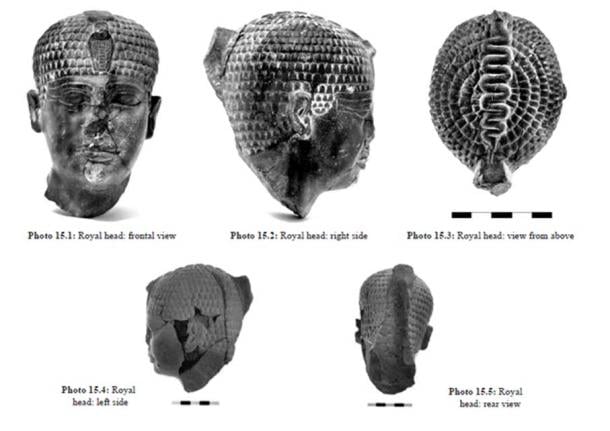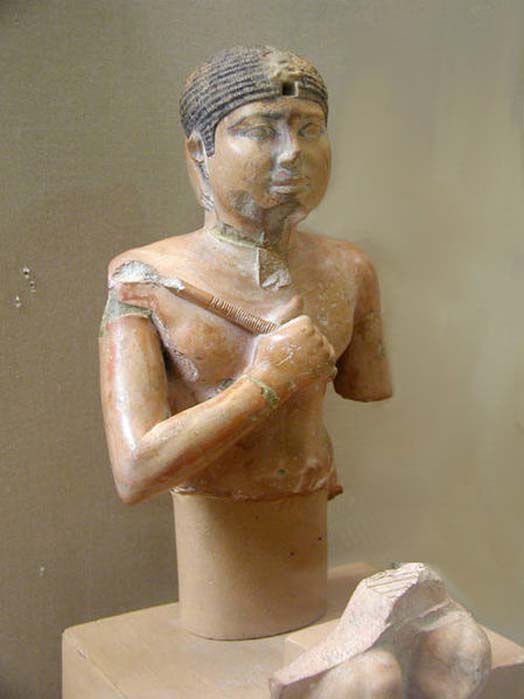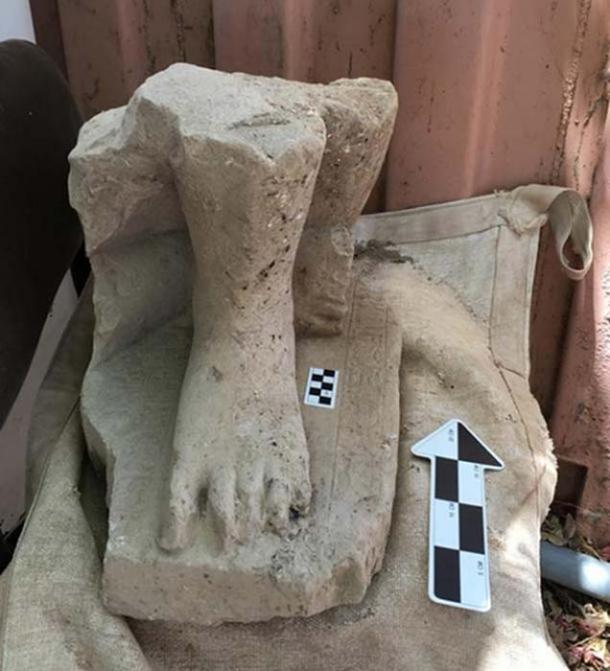- Joshua and the destruction of Hazor: From myth to reality
- Monumental 4500-Year-Old Statue of an Egyptian Official Discovered at Tel Hazor
Let’s explore the possible identity of the pharaoh first.
In their report (PDF), Dimitri Laboury, a senior research associate at the Belgian National Foundation for Scientific Research (F.R.S.-FNRS) at the University of Liège, and Simon Connor, a curator at the Museo Egizio in Turin, Italy, described the artifact as such:
“The person depicted wears a short, close-fitting curled capwig, topped by a uraeus, the solar cobra that rises above the forehead of Pharaoh in ancient Egyptian iconography, thus identifying our character as a king of Egypt beyond any doubt. The thin, high and somewhat irregular stone projection behind the head suggests that the statuette, almost half life-size, was not free-standing, but was leaning against a dorsal panel or a back slab, possibly within a group sculpture, along with a divinity or a female consort (or even a doubled royal representation).”

The pharaoh’s head artifact found at Hazor. Image from “Hazor VII: The 1990-2012 Excavations, the Bronze Age” (p. 576) ( Israel Exploration Society )
The researchers write in their report that the head was crafted out of “a piece of graywacke, a metamorphic rock only quarried in the ancient Near East in Wadi Hammamat.” This supports the idea that the artifact came from Egypt. The style of the facial features depicted on the artifact pinpoint its creation to the 5th Dynasty (ca. 2465-2323 BC).
Only nine known pharaohs reigned during that period, so it should be relatively easy to identify the pharaoh portrayed on the artifact, right? Unfortunately, no because the “physiognomy is derived from the official portrait of King Menkaure (also known as Mycerinus), from the late 4th Dynasty” –this was the image practically all pharaoh portraits had until the 6th Dynasty. The typology of the headgear on the artifact doesn’t help to narrow down the pharaoh shown either, as it is apparently common in the royal iconography of the 5th Dynasty as well.

Statue of Neferefre. Abusir. JE 98171, 34 cm. Cairo Egyptian Museum. ( Jon Bodsworth ) Neferefre’s reign only lasted for a couple of years in the 5th Dynasty period.
In their report Laboury and Connor write, “The history of the statue was surely quite complex, and the kingdom of Hazor must have been eager to use and display a prestige object connected to Egyptian royal imagery.”
Live Science reports that another team of scholars wrote in the recently published book: “Given Hazor's location in northern Israel, the number of Egyptian statues and statuary fragments uncovered at the site is surprising.”
However, it is worthwhile to note that a previous article on Ancient Origins by Sam Bostrom shows the sculpture wasn’t the only of its kind to be found at the site. Another damaged depiction of an Egyptian official was found at Hazor in 2016. It was:
“A large fragment of an Egyptian statue measuring 45 X 40 centimeters made of limestone was unearthed. Only the lower part of the statue survived, depicting the crouching feet of a male figure, seated on a square base on which a few lines in the Egyptian hieroglyphic script are inscribed. The archaeologists estimate that the complete statue would equal the size of a fully-grown man. At present only a preliminary reading of the inscriptions has been attempted, and the title and name of the Egyptian official who originally owned the statue, are not yet entirely clear.”

The remains of a monumental Egyptian statute of a high official from the Middle Kingdom in Egypt, found in the administrative palace at Hazor, north of the Sea of Galilee in Israel. (Photo credit: Shlomit Bechar )